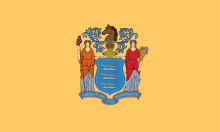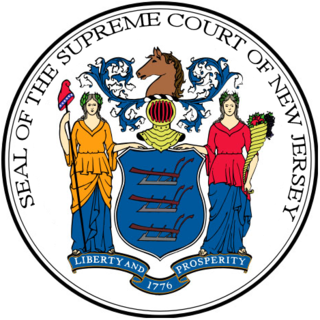
The 1844 New Jersey Constitution is the second state constitution for the State of New Jersey and was replaced by the current state constitution adopted in 1947. It was preceded by the 1776 New Jersey Constitution.

The 1844 New Jersey Constitution is the second state constitution for the State of New Jersey and was replaced by the current state constitution adopted in 1947. It was preceded by the 1776 New Jersey Constitution.

New Jersey is a state situated within both the Mid-Atlantic and Northeastern regions of the United States. It is the most densely populated of all 50 U.S. states, and is situated at the center of the Northeast megalopolis. New Jersey is bordered on its north and east by New York state; on its east, southeast, and south by the Atlantic Ocean; on its west by the Delaware River and Pennsylvania; and on its southwest by Delaware Bay and Delaware. At 7,354 square miles (19,050 km2), New Jersey is the fifth-smallest state in land area, but with close to 9.3 million residents as of the 2020 United States census, its highest decennial count ever, it ranks 11th in population. The state capital is Trenton, and the state's most populous city is Newark. New Jersey is the only U.S. state in which every county is deemed urban by the U.S. Census Bureau with 13 counties included in the New York metropolitan area, seven counties in the Philadelphia metropolitan area, and Warren County, part of the heavily industrialized Lehigh Valley metropolitan area.

The governor of New Jersey is the head of government of the U.S. state of New Jersey. The office of governor is an elected position with a four-year term. There is a two consecutive term term limit, with no limitation on non-consecutive terms. The official residence of the governor is Drumthwacket, a mansion located in Princeton, New Jersey. The governor’s office is located inside of the New Jersey State House in Trenton, making New Jersey notable as the executive’s office is located in the same building as the legislature. New Jersey is also notable for being one of the few states in which the governor’s official residence is not located in the state capital.

William Paterson was an American statesman, lawyer, jurist, and signer of the United States Constitution. He was an Associate Justice of the United States Supreme Court, the second governor of New Jersey, and a Founding Father of the United States.

The New Jersey Legislature is the legislative branch of the government of the U.S. state of New Jersey. In its current form, as defined by the New Jersey Constitution of 1947, the Legislature consists of two houses: the General Assembly and the Senate. The Legislature meets in the New Jersey State House, in the state capital of Trenton.

The Province of New Jersey was one of the Middle Colonies of Colonial America and became the U.S. state of New Jersey in 1776. The province had originally been settled by Europeans as part of New Netherland but came under English rule after the surrender of Fort Amsterdam in 1664, becoming a proprietary colony. The English renamed the province after the island of Jersey in the English Channel. The Dutch Republic reasserted control for a brief period in 1673–1674. After that it consisted of two political divisions, East Jersey and West Jersey, until they were united as a royal colony in 1702. The original boundaries of the province were slightly larger than the current state, extending into a part of the present state of New York, until the border was finalized in 1773.
The New Jersey Plan was a proposal for the structure of the United States Government presented during the Constitutional Convention of 1787. Principally authored by William Paterson of New Jersey, the New Jersey Plan was an important alternative to the Virginia Plan proposed by James Madison and Edmund Randolph of Virginia.

The Supreme Court of New Jersey is the highest court in the U.S. state of New Jersey. In its current form, the Supreme Court of New Jersey is the final judicial authority on all cases in the state court system, including cases challenging the validity of state laws under the state constitution. It has the sole authority to prescribe and amend court rules and regulate the practice of law, and it is the arbiter and overseer of the decennial legislative redistricting. One of its former members, William J. Brennan Jr., became an associate justice of the Supreme Court of the United States.

The Constitution of the State of New Jersey is the basic governing document of the State of New Jersey. In addition to three British Royal Charters issued for East Jersey, West Jersey and united New Jersey while they were still colonies, the state has been governed by three constitutions. The first was adopted on July 2, 1776, shortly before New Jersey ratified the United States Declaration of Independence and the second came into effect in 1844. The current document was adopted in 1947 and has been amended several times.

The history of what is now New Jersey begins at the end of the Younger Dryas, about 15,000 years ago. Native Americans moved into New town reversal of the Younger Dryas; before then an ice sheet hundreds of feet thick had made the area of northern New Jersey uninhabitable.
New Jersey is one of the fifty U.S. states. The state is considered a stronghold of the Democratic Party and has supported the Democratic candidate in every presidential election since 1992. Democrats have also controlled both chambers of the state legislature since 2004. New Jersey currently has two Democratic United States senators. New Jersey's Class I Senate seat has been Democratic since 1959. New Jersey's Class II Senate seat has been Democratic since 1979. In addition, New Jersey's House congressional delegation has had a Democratic majority since 1965, except for a period between 1995-1999 and 2013-2017. As of July 1, 2020, there were more registered Democrats than unaffiliated voters for the first time in history, as there are more Democrats than Republicans as well.

The lieutenant governor of New Jersey is an elected constitutional officer in the executive branch of the state government of New Jersey in the United States. The lieutenant governor is the second highest-ranking official in the state government and is elected concurrently on a ticket with the governor for a four-year term. The position itself does not carry any powers or duties other than to be next in the order of succession, but the state constitution requires that the lieutenant governor also be appointed to serve as the head of a cabinet-level department or administrative agency within the governor's administration, other than the position of Attorney General.
The Superior Court is the state court in the U.S. state of New Jersey, with statewide trial and appellate jurisdiction. The New Jersey Constitution of 1947 establishes the power of the New Jersey courts. Under the State Constitution, "'judicial power shall be vested in a Supreme Court, a Superior Court, and other courts of limited jurisdiction.'" The Superior Court has three divisions: the Appellate Division is essentially an intermediate appellate court while the Law and Chancery Divisions function as trial courts. The State Constitution renders the New Jersey Superior Court, Appellate Division the intermediate appellate court, and "[a]ppeals may be taken to the Appellate Division of the Superior Court from the law and chancery divisions of the Superior Court and in such other causes as may be provided by law." Each division is in turn divided into various parts. "The trial divisions of the Superior Court are the principal trial courts of New Jersey. They are located within the State's various judicial geographic units, called 'vicinages,' R. 1:33-2(a), and are organized into two basic divisions: the Chancery Division and the Law Division".
Prior to 1947, the structure of the judiciary in New Jersey was extremely complex, including Court of Errors and Appeals in the last resort in all causes.

The government of the State of New Jersey is separated into three distinct branches: legislative, executive, and judicial. The powers of the State of New Jersey are vested by the Constitution of New Jersey, enacted in 1947, in a bicameral state legislature, the Governor, and the state courts, headed the New Jersey Supreme Court. The powers and duties of these branches are further defined by acts of the state legislature, including the creation of executive departments and courts inferior to the Supreme Court.

Elections in New Jersey are authorized under Article II of the New Jersey State Constitution, which establishes elections for the governor, the lieutenant governor, and members of the New Jersey Legislature. Elections are regulated under state law, Title 19. The office of the New Jersey Secretary of State has a Division of Elections that oversees the execution of elections under state law. In addition, the New Jersey Election Law Enforcement Commission (ELEC) is responsible for administering campaign financing and lobbying disclosure.
The law of New Jersey consists of several levels, including constitutional, statutory, regulatory, case law, and local law.

The 1844 New Jersey gubernatorial election was held on October 8, 1844. Whig nominee Charles C. Stratton defeated Democratic nominee John Renshaw Thomson with 50.94% of the vote.

United States gubernatorial elections are scheduled to be held on November 4, 2025, in two states, New Jersey and Virginia. These elections form part of the 2025 United States elections. The last gubernatorial elections for New Jersey and Virginia were in 2021. Both incumbents are in-eligible to run for re-election due to term limits. More states may hold elections due to a gubernatorial vacancy or recall of a governor.